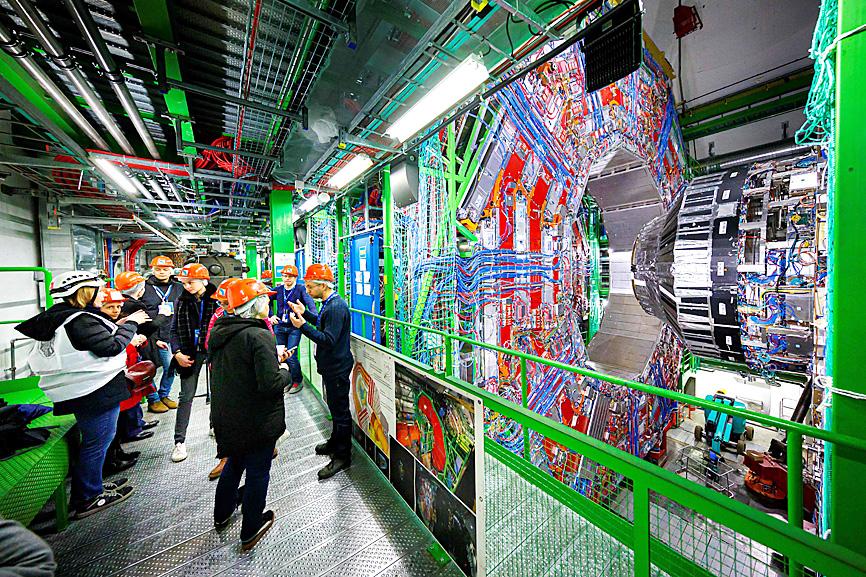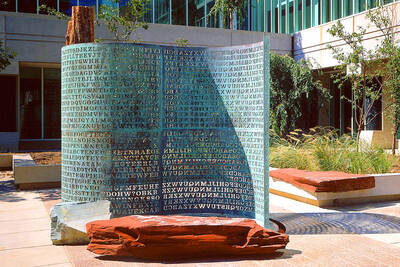Ten years after it discovered the Higgs boson, the Large Hadron Collider is about to start smashing protons together at unprecedented energy levels in its quest to reveal more secrets about how the universe works.
The world’s largest and most powerful particle collider started back up in April after a three-year break for upgrades in preparation for its third run. From today it will run around the clock for nearly four years at a record energy of 13.6 trillion electronvolts, the European Organisation for Nuclear Research (CERN) announced at a news conference last week.
It is to send two beams of protons — particles in the nucleus of an atom — in opposite directions at nearly the speed of light around a 27km ring buried 100m under the Swiss-French border.

Photo: AFP
The resulting collisions would be recorded and analyzed by thousands of scientists as part of a raft of experiments, including ATLAS, CMS, ALICE and LHCb, which would use the enhanced power to probe dark matter, dark energy and other fundamental mysteries.
“We aim to be delivering 1.6 billion proton-proton collisions per second” for the ATLAS and CMS experiments, CERN’s head of accelerators and technology Mike Lamont said.
This time around the proton beams will be narrowed to less than 10 microns — a human hair is about 70 microns thick — to increase the collision rate, he said.
The new energy rate would allow scientists to further investigate the Higgs boson, which the Large Hadron Collider first observed on July 4, 2012.
The discovery revolutionized physics in part because the Higgs boson fit within the Standard Model — the mainstream theory of all the fundamental particles that make up matter and the forces that govern them.
“The Higgs boson is related to some of the most profound open questions in fundamental physics today,” said CERN director-general Fabiola Gianotti, who first announced the Higgs boson’s discovery a decade ago.
Compared with the collider’s first run that discovered the Higgs boson, this time around there would be 20 times more collisions.
“This is a significant increase, paving the way for new discoveries,” Lamont said.
CERN head of research and computing Joachim Mnich said that there was still much more to learn about the Higgs boson.
“Is the Higgs boson really a fundamental particle or is it a composite?” he asked. “Is it the only Higgs-like particle that exists — or are there others?”
Experiments have determined the mass of the Higgs boson, as well as more than 60 composite particles, but CERN theoretical physics department head Gian Giudice said observing particles is only part of the job.
“Particle physics does not simply want to understand the how — our goal is to understand the why,” he said.
Among the Large Hadron Collider’s nine experiments is ALICE, which probes the matter that existed in the first 10 microseconds after the Big Bang, and LHCf, which uses the collisions to simulate cosmic rays.
After this run, the collider is to come back in 2029 as the High-Luminosity LHC, increasing the number of detectable events by a factor of 10.
Beyond that, scientists are planning a Future Circular Collider — a 100km ring that aims to reach energies of 100 trillion electronvolts, but for now, physicists are keenly awaiting results from the Large Hadron Collider’s third run.
“A new physics season is starting,” CERN said.

DISASTER: The Bangladesh Meteorological Department recorded a magnitude 5.7 and tremors reached as far as Kolkata, India, more than 300km away from the epicenter A powerful earthquake struck Bangladesh yesterday outside the crowded capital, Dhaka, killing at least five people and injuring about a hundred, the government said. The magnitude 5.5 quake struck at 10:38am near Narsingdi, Bangladesh, about 33km from Dhaka, the US Geological Survey (USGS) said. The earthquake sparked fear and chaos with many in the Muslim-majority nation of 170 million people at home on their day off. AFP reporters in Dhaka said they saw people weeping in the streets while others appeared shocked. Bangladesh Interim Leader Muhammad Yunus expressed his “deep shock and sorrow over the news of casualties in various districts.” At least five people,

ON THE LAM: The Brazilian Supreme Court said that the former president tried to burn his ankle monitor off as part of an attempt to orchestrate his escape from Brazil Former Brazilian president Jair Bolsonaro — under house arrest while he appeals a conviction for a foiled coup attempt — was taken into custody on Saturday after the Brazilian Supreme Court deemed him a high flight risk. The court said the far-right firebrand — who was sentenced to 27 years in prison over a scheme to stop Brazilian President Luiz Inacio Lula da Silva from taking office after the 2022 elections — had attempted to disable his ankle monitor to flee. Supreme Court judge Alexandre de Moraes said Bolsonaro’s detention was a preventive measure as final appeals play out. In a video made

It is one of the world’s most famous unsolved codes whose answer could sell for a fortune — but two US friends say they have already found the secret hidden by Kryptos. The S-shaped copper sculpture has baffled cryptography enthusiasts since its 1990 installation on the grounds of the CIA headquarters in Virginia, with three of its four messages deciphered so far. Yet K4, the final passage, has kept codebreakers scratching their heads. Sculptor Jim Sanborn, 80, has been so overwhelmed by guesses that he started charging US$50 for each response. Sanborn in August announced he would auction the 97-character solution to K4

SHOW OF FORCE: The US has held nine multilateral drills near Guam in the past four months, which Australia said was important to deter coercion in the region Five Chinese research vessels, including ships used for space and missile tracking and underwater mapping, were active in the northwest Pacific last month, as the US stepped up military exercises, data compiled by a Guam-based group shows. Rapid militarization in the northern Pacific gets insufficient attention, the Pacific Center for Island Security said, adding that it makes island populations a potential target in any great-power conflict. “If you look at the number of US and bilateral and multilateral exercises, there is a lot of activity,” Leland Bettis, the director of the group that seeks to flag regional security risks, said in an